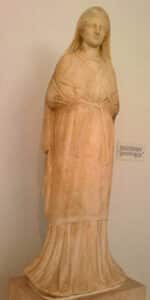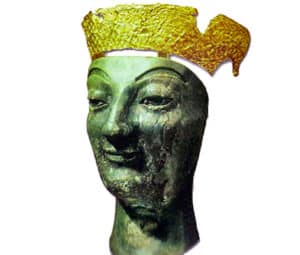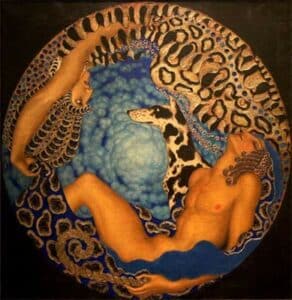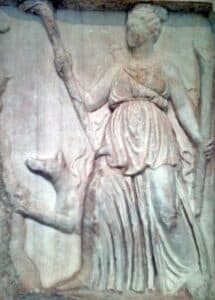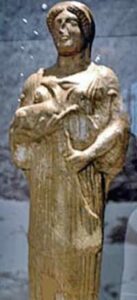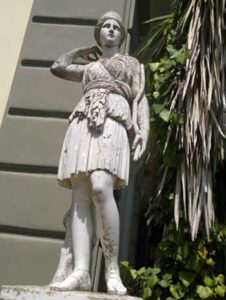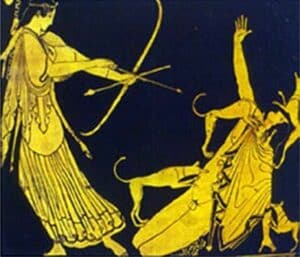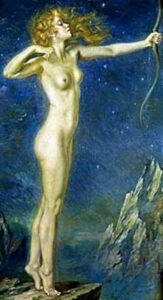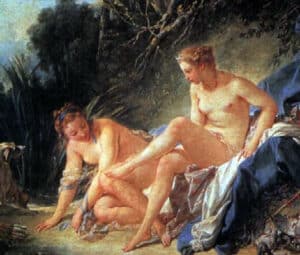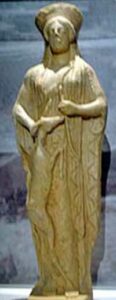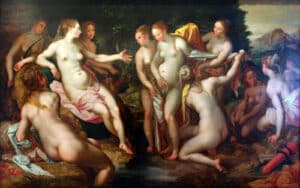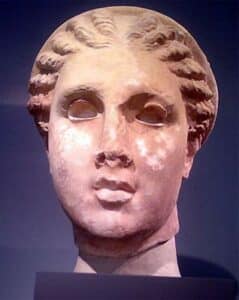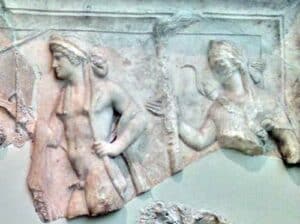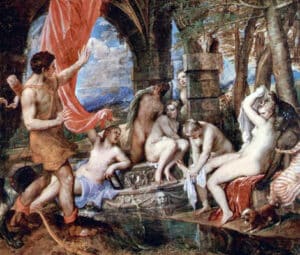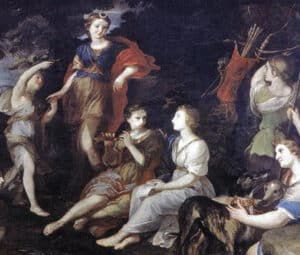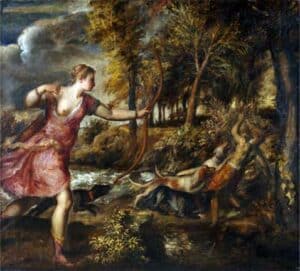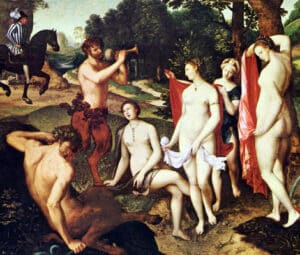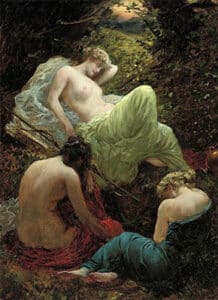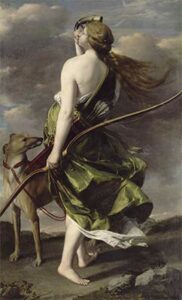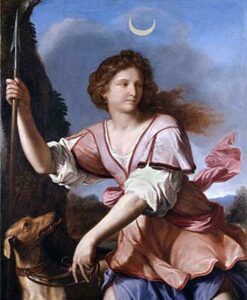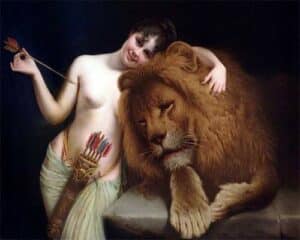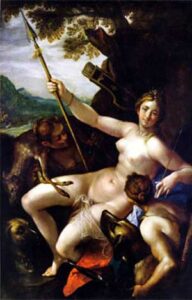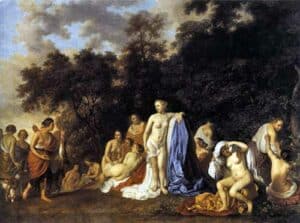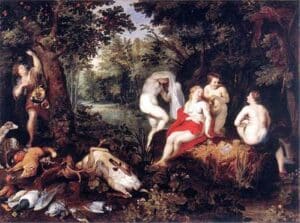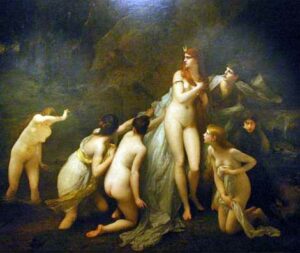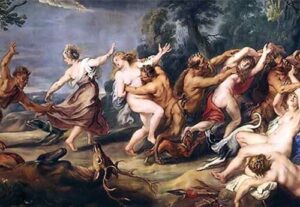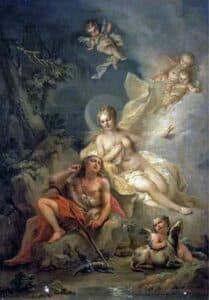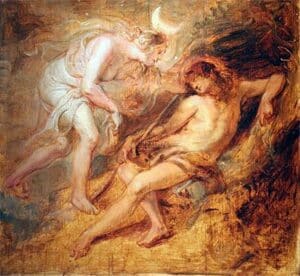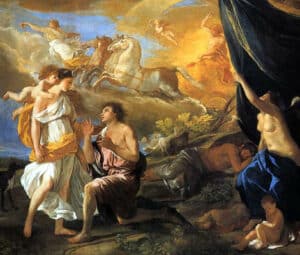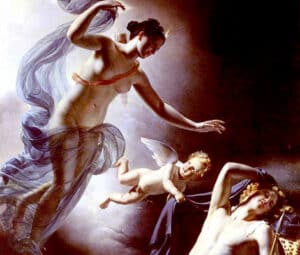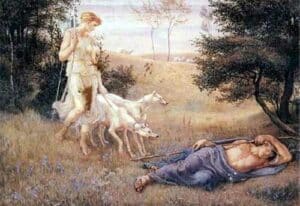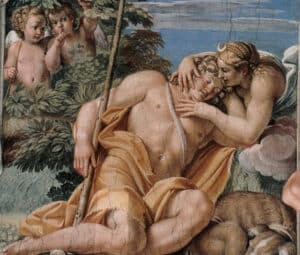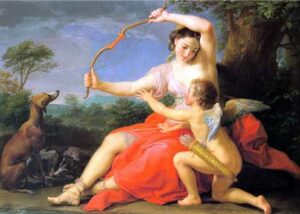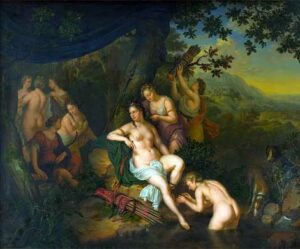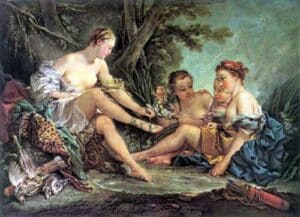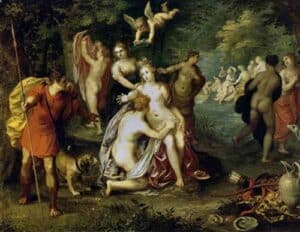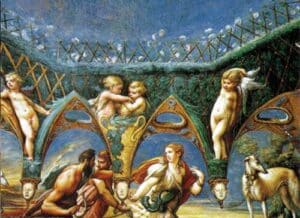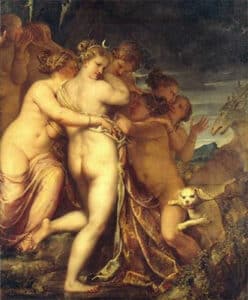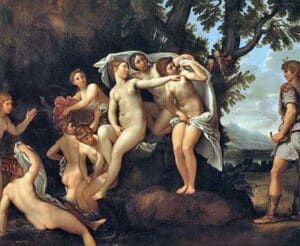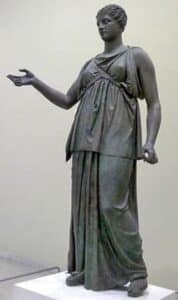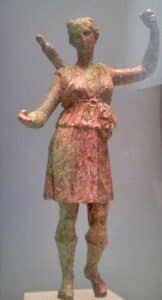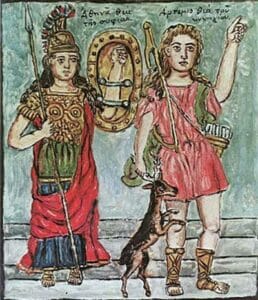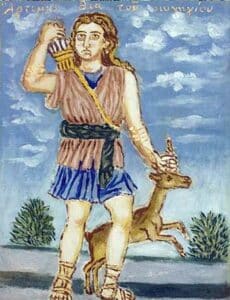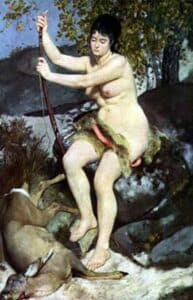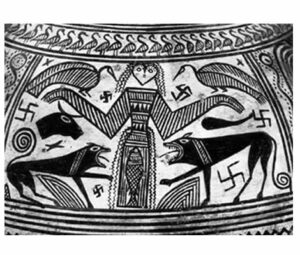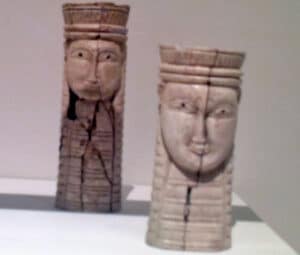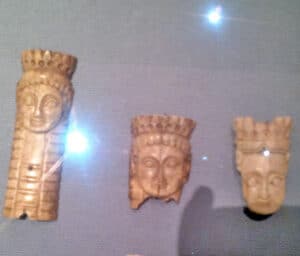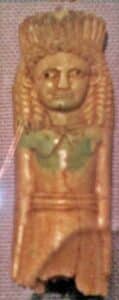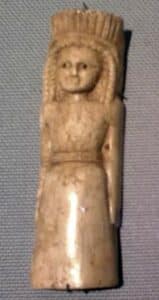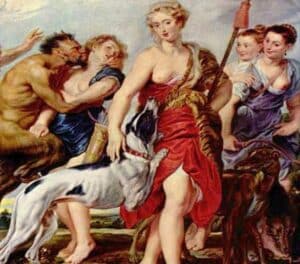Artemis was the Goddess of Hunting, the Moon, Childbirth, Wild Animals, and, in general, the Wilderness. She was also in charge of protecting the young girls until they married. Her sacred symbols included her weapons (bow, arrows, spears, knives), the crescent moon, animal pelts, amaranth, her beloved deer, and a variety of other animals.
Key Facts
Family tree
| Parents | Zeus and Leto |
| Partner(s) | None |
| Siblings | Aphrodite, the goddess of love, Apollo, Ares, the god of war, Athena, the goddess of wisdom, Dionysus, Hermes, God of All Trades, Hephaestus, Aeacus, Angelos, Eileithyia, Enyo, the goddess of war, Eris, Ersa, Hebe, Helen, The Most Beautiful Woman In The World, Heracles, The Strongest Hero, Minos, Pandia, Persephone, The Enigmatic Queen of the Underworld, Perseus, The Legendary Slayer of Medusa, Rhadamanthus, the Charites (Graces), The epitome of charm and beauty, the Horae, the Litae, the Muses, The Divine Inspirations Behind Art, Science, and Culture, the Moirai, Spinners of The Thread of Life |
| Offspring | None |
Names & Others
| Roman Name | Diana |
| Other Names | Artemi, Phoebe |
| Ancient Greek | Ἄρτεμις |
| The God of | Hunting, the Moon, Childbirth, Wilderness, Wild Animals, Nature, Vegetation, Protecting young children, Chastity |
| Symbols | Bow, Arrow, Crescent Moon, Animal Pelts, Torch, Amaranth, Deer, Bear, Bore, Dog, Goat, Serpent, Cypress, Palm, Walnut |
Name and Etymology
The origins of the name Artemis are unknown. It is most likely pre-Greek in origin. The name could be derived from the Greek word arktos (ἄρκτος), which means bear. This could be related to the goddess’s bear cult in Attica.
The name Artemis first appears in Linear B, written as a-te-mi-to, on some plaques on Pylos. The name’s origins could also be Phrygian or Persian. It could originate from the Persian *arte, which means “excellent” or “holy“. This could be a reference to Artemis, the goddess-mother of Nature.
Of course, Plato in his Cratylus entertains the notion that the name Artemis comes from ἀρτεμής. That etymology would indicate Artemis’ purity.
The Egyptians identified her with Bastet, the cat goddess, while the Romans identified her with Diana. Artemis is possibly related to Skadi, the goddess of hunting and the mountains, in Norse mythology.
Artemis’ Epithets
The majority of Artemis’ epithets are related to her patronage or the locations where she was worshipped.
The most well-known Artemis epithets associated with the locations where she was worshiped are Aetole, Alphaea, Cynthia, Isora, and Leucophryne.
As a patroness of hunting and wilderness, we find the following epithets referring to Artemis:
- Aeginaea, meaning huntress
- Agrotera, the patroness of hunters
- Chitone, from wearing a chiton when hunting
- Dictynna, the one who holds a hunter’s net
- Heurippa, the finder of horses
- Potnia Theron, patroness of the wild animals (Homer)
- Tauropolos, the one pulled by bulls or hunting with bulls
Other epithets associated with her because of what she protects include:
- Aristo, the best
- Aristoboule, the one who gives the best advice
- Hymnia and Molpadia, for her connection to music
- Kourotrophos, the one who protects the young
- Lygodesma, the one bound to the willow tree
Because she protected childbirth, the goddess was given many names, including Eileithyia, Eulochia, Geneteira, and Lochia.
Finally, as Apollo’s twin sister, they shared some epithets. As a result, the goddess was frequently called Daphnaea, Delphinia, Phoebe, The Luminous Titaness, and Pythia.
Artemis’ Origins and Family
Artemis is Apollo’s twin sister, the god of music and light. Their mother was Leto, and their father was Zeus. She was one of the second generation of the twelve, or fourteen Olympian gods and goddesses.
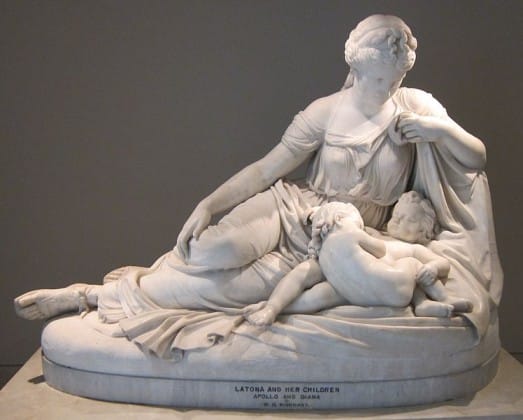
The majority of the information we have on the twins’ birth comes from works discussing Apollo. Only Callimachus’ Hymn to Artemis mentions the childhood of the goddess. The siblings’ twin status was previously unknown, as Homer and Hesiod only discuss how they are brothers and sisters, without mentioning that they are twins.
Hera had pursued Leto all over the world, attempting to prevent her from giving birth. Leto found refuge on the island of Delos, where she gave birth. Other accounts, however, state that the twins were born in Ortygia.
The firstborn child was Artemis. She was born at night as she was associated with the moon, whereas Apollo was born when the sun rose, as the god of light.
The goddess was born before Apollo in order to help her mother give birth to her brother. Hera forbade the birth of a second child after Artemis was born. Fortunately, Artemis learned how to assist in childbirth and helped her mother in giving birth.
Childhood
Little is known about her childhood. According to Callimachus’ Hymn to Artemis, when she was still young, she petitioned her father. The young goddess asked Zeus to grant her 10 wishes:
- Eternal chastity
- As many names as her brother, Apollo
- Her weapons, a bow and arrows made by the Cyclopes, One-Eyed Giant Monsters
- To be the bringer of Light
- To have a knee-length chiton in saffron color, so she could hunt with ease
- To have a choir made up of 60 young Oceanides
- To have 20 Amnisides (river Nymphs, Guardians of Nature) to watch her dogs and weapons while she rests
- To rule over the mountains
- To be assigned to a city
- To help women with their childbirth
This led to Artemis being the goddess she was. She spent all of her childhood seeking out anything that would make her a huntress. After acquiring her bow and arrows, she visited Pan. The demigod gave her 13 hounds. The last acquisition was six deer with gold horns that pulled her chariot.
Artemis’ Lovers
Artemis was one of the goddesses who had vowed to be celibate for the rest of her life. As a result, she had no romantic relationships with men.
She was working to protect not only her own innocence but also the innocence of her worshippers. As we will see later, this could be a double-edged sword.
The Huntress’ Aspiring Suitors
The fact that the goddess swore to be a virgin forever did not mean that there weren’t willing suitors.
Alpheus, the river God, fell in love with the goddess. Knowing that it would never happen he decides to abduct her. She understands the plan and covers her face with mud, so he doesn’t recognize her. According to some accounts, Alpheus attempts to capture Arethusa, one of Artemis’ followers. The goddess feels sorry for her and transforms her into a spring.
Bouphagos just had a thought of throwing himself onto Artemis. The goddess read his mind and stroke him down immediately.
Even men who saw the goddess naked by mistake were not spared. Artemis turned Siproites into a woman and Calydon into stone for seeing her bathing naked.
Orion
According to Istrus, the only man Artemis might have been interested in was Orion, The Celestial Hunter, her hunting companion. No one, not even her brother, could persuade the goddess not to marry him.
Apollo however decided to deceive her. Orion was swimming one day when Apollo pointed at him. He told his sister that he didn’t think she was a good enough archer to hit that barely visible dot (which was, actually, Orion). Artemis accepted the challenge and shot the “dot,” killing Orion. Heartbroken about what she had done, she decided to turn Orion into an asterism.
Artemis’ Offspring
Atrtemis had no children because she was a sworn life-long virgin. The closes she had to children were her sworn followers. Everyone who followed her was under protection from the goddess.
Depiction and Characteristics
Artemis was a very recognizable goddess in antiquity. She had a distinct appearance as well as personality.
Artemis’ Appearance
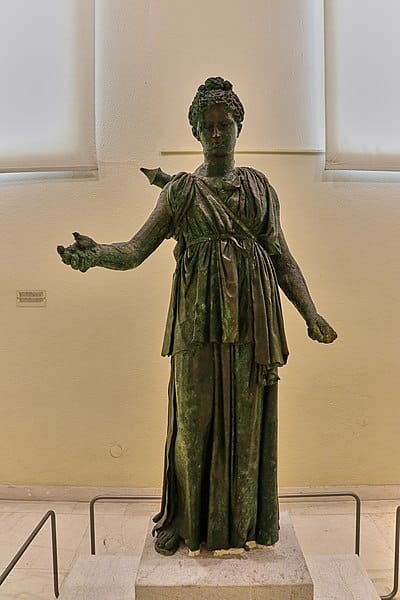
Artemis was one of the most easily identified goddesses in Greek mythology. In appearance, she was similar to the other goddesses. She had long, curly hair that was usually tied back. She was athletic and slim.
Her chiton was what set Artemis apart from the others. It was designed to be knee-length so she could hunt, whereas all the other goddesses wore long gowns. She was accompanied by a hide, and she also carried her quiver on her back. She wore a crescent moon symbol as a garment at times.
Artemis’ Personality
Artemis is a mysterious and fierce goddess. She is the protector of young women and a vowed virgin, but she also assists women during childbirth.
She is not however, a soft-spoken goddess. She is ferocious, fierce, and passionate. She is vengeful and defensive, and she goes after anyone who harms or threatens those she loves or protects. The first example was how she assisted her mother, Leto, when Niobe was disrespectful to her.
Artemis is a nurturer and protector, but she is also a destroyer. She is always protecting women (virgins, maidens, and mothers), as well as wild animals, and she rages against anyone who would harm them – men, in particular. She will not tolerate disrespect or violence, and she will punish hunters, murderers, abusers, and any man who would harm her beloved animals or her protegees, women, and children.
The great huntress shoots her arrows at will. She can use them to spread the plague on those who disrespect her, but she can also use them to grant painless death to dying women.
The moon phases can be used to depict the tenacious and free-spirited goddess. She is the archetype of the fierce woman, ever-changing and powerful, who will go after anyone who harms those she protects.
Artemis’ Powers
Artemis, as an Olympian, possessed all of the goddesses’ common abilities: she was immortal and invulnerable, had superhuman stamina and strength, and was omnipresent and eternally young.
The goddess was an expert archer. She had perfect aim with her bow and arrow. She used it for both hunting and spreading disease among the people. Artemis was an excellent strategist and observant hunter.
Artemis could also transform into any animal she desired. Not only that, but she had complete command of nature.
Sacred Symbols
Artemis possessed a wide range of sacred symbols. Her sacred objects were, first and foremost, her weapons. The Cyclopes had given her the bow and arrows she carried around with her. She used them for hunting, inflicting disease on those who enraged them, and granting painless death to dying women. When she wasn’t using the bow and arrows, she had some hunting spears.
The goddess was also frequently depicted with torches or a lyre in her hands. The torches would allow her to identify with Hecate. Furthermore, Apollo’s sister was a Goddess of Music as well. That’s why she’s sometimes shown holding a lyre. She also wore a crown with a crescent moon, as the goddess of the moon.
Artemis’ Sacred Animals / Plants
She was the protectress of wild animals, the wilderness, and nature in general. As a result, she held many sacred plants and even more sacred animals.
Her sacred plants included the amaranth, the asphodel, the cypress, the palm, and the walnut.
- The amaranth was connected with the goddess through her Euboean cult.
- The asphodel was a flower connected to the underworld and associated with Cthonian Artemis.
- The cypress tree was sacred to the twins, as it was connected with Ortygia, their possible place of birth.
- The palm tree was also connected to the twins’ birth, and it was sacred to both, as well as Leto.
- The walnut was sacred to Artemis Caryatis, also known as the Lady of the Walnut; her priestesses were known as Caryatides and were represented by the nine infamous marble statues in Athens’ Erechtheum temple.
As the protectress of nature, she had a great number of sacred animals as well. Some of Artemis’ sacred animals were the deer, which also drew her chariot, the bear, the bore, the hounds, the goats, the fresh-water fish, and the serpent. Also sacred to the goddess was the Ceryniteian hind, an immortal deer with golden horns.
Artemis’ Roles and Responsibilities
The goddess had multiple roles and responsibilities, being the protectress of various things. Her job as patroness of hunting and protector of the wilderness was difficult. She was not only in charge of hunting, but she also prohibited the hunting of wild animals and protected them at all costs. That includes going so far as to kill those who pursued them.
As the goddess of chastity, she had to fiercely guard her own innocence as well as the innocence of her followers. She also protected young girls, so if anyone violated their purity and/or harmed them, she would go after them as well.
The goddess was generally vengeful and spiteful, and she did not tolerate anyone injuring her proteges or her beloved animals.
She was not only the goddess of chastity but also the goddess of childbirth. She assisted mothers in giving birth and protected female children as they grew. Artemis also protected the maidens up until their marriage and was not very fond of the latter.
In addition to these, Artemis was the goddess of the dawn and the moon. She is the Light Bringer. She was also the bringer of disease and sudden death. The skilled archer would destroy anyone who did something harmful or disrespectful, but she could also cause people suffering from illnesses to die suddenly.
Because of her responsibilities and their importance, she was usually identified with Selene, the goddess of the moon, Hecate (the goddess of witchcraft and the night), and Britomartis (the goddess of hunting and fishing).
Myths About Artemis
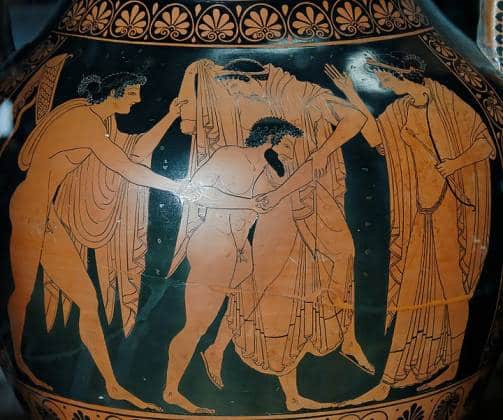
The great huntress was the heroine of many myths, particularly stories of vengeance. She was mostly involved in punishing or helping hunters and maidens.
Avenger of Leto
Artemis’ first act of vengeance was to avenge her mother, Leto. Hera had sent a Drakon named Python to kill Leto while she was still pregnant. Although most myths claim that only Apollo killed the dragon, others claim that she was also involved.
Tityus, a giant who pursued Leto while she was still pregnant, was also killed by the twins. They killed him with their arrows and sent him for eternal torture in Hades.
The most well-known Leto-avenging myth, though, is the one of Niobe. Niobe was a mortal and the mother of over a dozen children. She boasted that Leto had given birth to two children, but she had given birth to an entire Olympus. Apollo and Artemis set out to reestablish their mother’s reputation. Apollo murdered the seven sons and she murdered the seven daughters. The youngest child, Chloris, is said to have been spared.
Artemis & Heracles
During his 12 labors, Heracles had to capture the Ceryneian Hind, Artemis’ sacred animal. Eurystheus sent Heracles to capture the hind, believing that Artemis would kill the demi-god.
However, Heracles begged the goddess to forgive him. She let him go but told him to go and inform Eurystheus that she met with him. The task was completed, but then the goddess targeted king Eurystheus.
Trojan War
Artemis, as well as her brother, took the side of the Trojans during the Trojan War.
Before the Greeks started their expedition, Agamemnon slew the goddess’ sacred deer. To retaliate, she led and stranded their ships in Aulis. She demanded that Agamemnon, The Mighty King and Central Figure of the Trojan War sacrifice his youngest daughter, Iphigeneia, as compensation.
Story has it that Agamemnon agreed to sacrifice his daughter. However, Artemis changed her mind at the final moment and pitied the girl. She rescued her and left another deer in her place.
After Patroclus’ death, Artemis stood against Hera that was on the Greek side. However, Hera beat her.
Protector of Atalanta
Atalanta was a renowned huntress who as baby was abandoned by her father andleft in the woods. Artemis interweaned and sent a she-bear to protect and raise her. As she grew, her dedication to the hunt and her vow of chastity endeared her to Artemis. Recognizing her unwavering devotion, she blessed Atalanta with unmatched agility and prowess in hunting. When Atalanta took part in the Calydonian Boar Hunt, it was with the goddess’s favor that she became the first to strike the creature, solidifying her reputation and Artemis’s protective guidance over her.
Defender of Purity
The goddess was a fierce protector of innocence, virginity, and purity in general. She transformed Actaeon into a stag and sent her dogs to tear him apart because he saw her naked in the bath. She did something similar – but gentler – to Sipriotes, whom he transformed into a girl.
The giant Aloadae twins stormed Olympus once to marry Artemis and Hera. The goddess transformed into a deer and charged between the giants, causing them to throw their spears at each other. On a more straightforward note, she killed Bouphagos with her arrows after he attempted to violate her.
Defender of the Divine Privilege
Another thing Artemis could not stand was disregard for religious responsibilities. As an example:
- She punished Admetus, a Thessalian king, for not offering Artemis matrimonial sacrifices. She filled his bridal chamber with serpents.
- In another take of Agamemnon’s story, Atreus, his father, is the one earning her wrath. He had promised the goddess his best sheep, but when a golden lamb was born, he kept it for himself.
- Hippo, Cheiron’s daughter, scorned the worship of the goddess. For that, she was transformed into a mare.
- Oeneus had neglected the goddess by not offering the first fruits of the season to her. In retaliation, she sent a boar that ravages his lands. Oeneus asked Meleagros and some hunters to help. The goddess answered by sparking conflict between them. That resulted in a war between the Calydonians and the Couretes.
- The Corinthians had not accepted the twins when they asked for purification after slaying Python, The Ancient Serpent. Wrathful, they brought a plague upon the town. The gods were appeased only after the Corinthians offered seven boys and seven girls as suppliants.
Hunters
She would both punish and help hunters, depending on their actions. Her wrath has fallen over the following hunters:
- Adonis, a mortal of unparalleled beauty, for boasting that he was a superior hunter.
- Ancaeus, for boasting that not even Artemis could stop him from slaying the boar of Calydonia.
- Broteas, for boasting that he was superior and was driven mad as a punishment. He was the son of Tantalos and the brother of Niobe.
- Phalaecus, who offended her, so she sent a lion to kill him.
She had also favored some hunters:
- Atalanta was a
- Cyrene was a princess from Thessaly. She became a companion to the goddess and she gifted her a pair of gods that could have been magical.
- Daphne was a princess from Laconia who would hunt in Peloponnese. Artemis made her shoot straight.
- Hippolytus was a prince in Argos, devoted to the Goddess. When Aphrodite had him killed, Artemis could not stand it. She persuaded Asclepius, the god of medicine to revive him and she saved him by carrying him off to Italy.
- Procris was a young girl-hunting companion to the goddess. Her husband abandoned her for Eos, the goddess of the dawn and Artemis helped her win him back.
Orion
The famous giant Orion was a very skilled hunter. There are many versions as to why the goddess unleashed her wrath upon him. Some others, though, describe how much she loved and favored him.
Orion was a hunting companion to the goddess. Bragging that he would kill every monster on the earth, Gaia sent a giant scorpion to kill him. Artemis saved him by turning him into a bright constellation. Another account of this story describes how the goddess deeply loved Orion, accidentally killed him, and then turned him into a constellation.
In another story, Orion tried to violate one of the goddess’ followers, Opis, or even Artemis herself. The goddess killed him after this incident.
Finally, the goddess might have killed the skilled hunter because he tried to grab her robe. She then turned and hit him in an act of self-defense, killing him.
Maidens
Artemis could not stand hubris and disrespect. For that reason, she would punish any maiden who did not follow her words. On the opposite hand, she would apotheosize the ones who firmly stood by her.
Wrath towards Maidens
Her wrath had fallen onto many maidens, such as:
- Aura, the Titaness goddess of the breeze. She said that the body of Artemis was very “womanly” to be that of a virgin. Artemis sent Dionysus to force himself onto Aura so that she loses her virginity.
- Byssa, the arrogant princess of Kos. She insulted the goddess for her night-wandering and the gods transformed her into a sea-bird. They also transformed her siblings, Agron and Meropis, because they had insulted Hermes and Athena respectively.
- Callisto, a hunting companion. Zeus got her pregnant and she tried to hide it, violating the goddess’ circle of virgins. She felt distraught and turned Callisto into a bear.
- Chione was killed for claiming that she is more beautiful than her.
- Coronis had betrayed her lover, Apollo, with another man. To retaliate Artemis killed her with her arrows as she gave birth.
- Melanippe was transformed into a black horse for offending the goddess.
- Polyphonte was a hunting companion of the goddess. She slept with a bear following an unnatural desire. Artemis, disgusted, made all the wild animals chase her.
Favors Towards Maidens
However, the goddess favored many maidens, such as:
- Arethusa, a nymph and devotee to the goddess. When the river-God Alpheios went after her, she was transformed into a spring and got carried to Sicily. She became the holy spring of the shrine of the goddess.
- Aspalis, a lady that killed herself to protect her virginity before marriage. Artemis admired her and turned her into a statue, to be adored beside her.
- Britomartis, a nymph that rushed into the sea to protect herself from king Minos. Artemis made her an immortal companion.
- Iphigeneia, the daughter of Agamemnon, who was saved at the last moment (see Trojan War)
- Macaria-Eucleia, Phylonoe, and Polyboia who were turned into immortal companions of the goddess.
- Upis, Loxo, Hecaerge, the Hyperborean maidens. They had gone to Delos with offerings for the goddess. They died young and Artemis made them her immortal companions to thank them for their devotion.
Artemis in Ancient Greek Religion
The Ancient Greeks and Romans held Artemis in high regard. All over the known world, there were statues, shrines, and temples dedicated to her.
Sites Sacred to Artemis
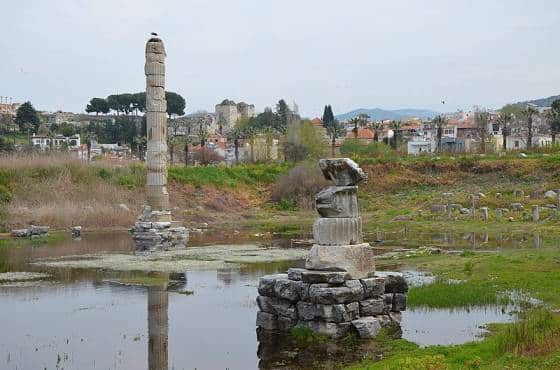
One can find multiple temples devoted to the goddess. However, the most well-known one was the Temple of Artemis in Ephesus. It was twice the size of the Parthenon and was regarded as the most beautiful temple in the world. The temple was regarded as one of the famous Seven Wonders of the World. It was so magnificent that it took about a century to be built and it was thought that Artemis herself had helped in its erection.
Other notable Greek temples include the ones in Brauron, Tauris, Caryae, and Delos. The temple of Brauron, in east Attica, is still visible today and was famous for its rites. Magnesia, Pyrgos, Sparta, Ikaria, Euboea, and many other Greek cities also had temples.
Worship & Festivals
Many festivals in Athens and throughout Greece honored Artemis. The most famous festival was the Braubronia, which took place near the famous temple. This festival served as the young girls’ initiation rite.
Other popular festivals included the Caphyae, Elaphebolia, Laphria, Munichia, and Thargelia. Both Apollo and Artemis were honored on the Thargelia. It originated in Delos but was also brought to Athens.
Try The Artemis Quiz
Can you answer all questions, without making Artemis angry with you? Play and find out!
You can also play around with Artemis’ and other Olympian gods’ names in this fun anagram game:
If you have finished these games and want more, try our other games! For example, this game about Leto, the mother of Artemis and Apollo.
Representations of Artemis in Art
Artemis was frequently depicted in Greek art. She is typically shown with her animal companions, holding her bow and arrows. She occasionally wears a crescent moon on her head.

The goddess appears in numerous vases and statues, such as Diana of Versailles in the Louvre. The goddess is depicted as a protagonist of various myths in Renaissance art. For example, Rubens showed the myth of Diana and Callisto admirably (1637-1638). Poussin depicts the Death of Chione in his first known work (1622).
In The Old Texts
The sources on Artemis’ life are consistent with those of all Olympians. In their works, Homer and Hesiod detail the goddess’ birth and life, as well as her role in the Trojan War. In addition to the well-known Homeric Hymn, Callimachus wrote a Hymn to Artemis that contains a wealth of information about the great huntress’ life.
The Roman poets have also written extensively about Artemis – or, more accurately, Diana. Diana’s life and works can be found in Ovid, Seneca, Nonnus, Hyginus, and many other works.
FAQs
Artemis was the goddess of hunting, wild animals and wilderness, the moon, dawn and frost, chastity and childbirth, disease and sudden death, as well as being the protectress of young girls.
Zeus and Leto.
She took the Trojan side, being especially hostile against Agamemnon.
Artemis had many sacred animals. Namely: deer, hounds, serpents, bears, boars, fish, hawks, and many others.
Possibly with Skadi, goddess of hunting and mountains
Sources
Featured Image Credit: Louvre Museum, Public domain, via Wikimedia Commons

